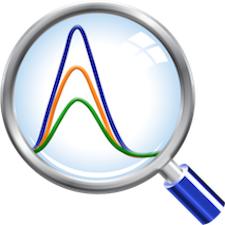Absorbance and fluorescence analysis are distinct yet complementary techniques used to detect and quantify analytes of interest in a sample. Measuring the absorbance of ultraviolet and visible (UV-Vis) light at specific wavelengths is one of the most established methods of quantitating biomolecules. Fluorescence analysis, meanwhile, has long been used to measure the emission spectra of fluorophores binding to samples excited by wavelengths for highly specific molecular quantification.
In this blog post, DeNovix explores four of the key differences between absorbance and fluorescence analysis.
1. Sensitivity
Both absorbance and fluorescence analysis are routinely used in life science laboratories for measurements of small sample volumes. The most sensitive microvolume spectrophotometer is capable of detection down to 0.75 ng/μl of double-stranded DNA in 1µL of the sample. Fluorescence analysis using DeNovix Ultra High Sensitivity assay kits yields picogram (pg) levels of sensitivity enabling detection down to 0.005 ng/μl.
2. Differences in Dynamic Range
The dynamic range of measurements is also a consideration in comparing methodologies. Absorbance surpasses fluorescence analysis with respect to the width of the measuring range. Taking dsDNA as an example, the broadest range of fluorescence quantification kits detect to 4000 ng/μl, while the upper limit in microvolume spectrophotometers is currently 37500 ng/μl.
3. Assay Requirements
An absorbance spectrophotometer directly measures the amount of a specific wavelength that is absorbed by a sample without dilution or assay preparation. Fluorescence analysis, by comparison, requires samples of interest to be bound with fluorescent reagents in an assay kit. Samples must also be compared against similar samples of known concentration. It is, therefore, necessary to prepare and measure a standard curve when performing fluorescence quantification assays.
4. Contamination Detection
While the specificity of fluorescence is a benefit to assessing the concentration of the analyte of interest, the resulting figure gives no insight into any contamination within the sample. In contrast, many different contaminants can be inferred from taking a spectrum of absorbance measurement across a range of wavelengths. Assessing ratios such as 260/280nm and 260/230nm gives valuable information and can be implemented as part of a sample quality control regime.
Absorbance and Fluorescence Analysis with DeNovix
DeNovix recognizes the benefits of combining absorbance and fluorescence analysis into a single comprehensive device that allows the scientist to exploit the benefits of each method. Our DS-11 Series combines the most sensitive microvolume UV-Vis spectrophotometer on the market alongside the best-in-class integrated fluorometer. This provides a wide dynamic range with enhanced sensitivity, alongside specific analyte quantification and contaminant detection.
If you would like any more information about performing absorbance and fluorescence analysis with our cutting-edge instruments, please do not hesitate to contact us.


